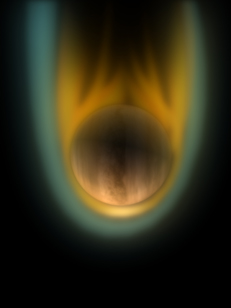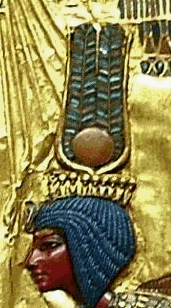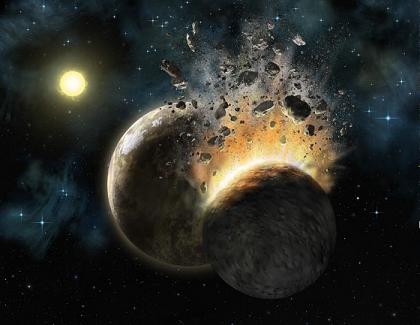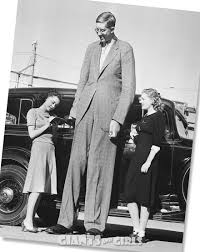
"Woe to thee, Moab! thou art undone, O people of Chemosh [
Saturn]:" -- Numbers 21:29
"And they forsook the LORD, and served Baal [Saturn] and Ashtaroth [Venus]." -- Judges 2:13
"Wilt not thou possess that which Chemosh [Saturn] thy god giveth thee to possess? So whomsoever the LORD our God shall drive out from before us, them will we possess." -- Judges 11:24
"Then did Solomon build a high place for Chemosh [Saturn], the abomination of Moab, in the hill that is before Jerusalem, and for Molech [Saturn], the abomination of the children of Ammon." -- I Kings 11:7
"Because they have forsaken me, and have worshipped Ashtoreth [Venus] the goddess of the Zidonians, Chemosh [Saturn] the god of the Moabites, and Milcom [Saturn] the god of the children of Ammon, and have not walked in my ways, to do that which is right in mine eyes, and to keep my statutes and my judgments, as did David his father." -- I Kings 11:33
"Then said Elijah unto the people, I, [even] I only, remain a prophet of the LORD; but Baal's [Saturn's] prophets [are] four hundred and fifty men." -- I Kings 18:22
"And they left all the commandments of the LORD their God, and made them molten images, even two calves, and made a grove, and worshipped all the host of heaven, and served Baal [Saturn]." --II Kings 17:16
"For he [Manasseh] built again the high places which Hezekiah his father had destroyed; and he reared up altars for Baal [Saturn], and made an Asherah, as did Ahab king of Israel, and worshipped all the host of heaven, and served them. -- II Kings 21:3
"And the high places that were before Jerusalem, which were on the right hand of the mount of corruption, which Solomon the king of Israel had builded for Ashtoreth [Venus] the abomination of the Zidonians, and for Chemosh [Saturn] the abomination of the Moabites, and for Milcom [Saturn] the abomination of the children of Ammon, did the king defile." -- II Kings 23:13
"And the houses of Jerusalem, and the houses of the kings of Judah, shall be defiled as the place of Tophet [Saturn], because of all the houses whose roofs they have burned incense unto all the host of heaven, and have poured out drink offerings unto other gods." -- Jeremiah 19:13
"For because thou hast trusted in thy works and in thy treasures, thou shalt also be taken: and Chemosh [Saturn] shall go forth into captivity with his priests and his princes together." -- Jeremiah 48:7
"And Moab shall be ashamed of Chemosh [Saturn], as the house of Israel was ashamed of Bethel [heaven] their confidence." -- Jeremiah 48:13
"Woe be unto thee, O Moab! the people of Chemosh [Saturn] perisheth: for thy sons are taken captives, and thy daughters captives." -- Jeremiah 48:46
"Seek him that maketh the seven stars [
Khima/Saturn] and Orion [Kesil/Mars], and turneth the shadow of death into the morning, and maketh the day dark with night: that calleth for the waters of the sea, and poureth them out upon the face of the earth: The LORD is his name:" -- Amos 5:8
"But ye have borne the tabernacle of your Moloch [Saturn] and
Chiun [Saturn] your images, the star of your god, which ye made to yourselves." -- Amos 5:26
"And them that worship the host of heaven upon the housetops; and them that worship and that swear by the LORD, and that swear by Malcham [Saturn];" -- Zephaniah 1:5
"Which maketh Arcturus [Aish], and Orion [Kesil/Mars], and Pleiades [Khima/Saturn], and the chambers of the south." -- Job 9:9
"Canst though bind the sweet influences of Pleiades [Khima/Saturn], or loose the bands of Orion [Kesil/Mars]? Canst thou bring forth Mazzaroth [Lucifer/Venus] in his season? or canst thou guide Arcturus [Aish] with his sons? Knowest thou the ordinances of heaven?" -- Job 38:31-33
"This is the way it is fated to be; and for you and your anger
I [Jupiter] care not; not if you stray apart to the undermost limits
of earth and sea, where Iapetos and Kronos [Saturn] seated
have no shining of the sun god Hyperion to delight them
nor winds delight, but Tartaros stands deeply about them."
-- Homeros, poet, Iliad, VIII:477-481, 8th century B.C.
"Hades [Pluto] trembled where he rules over the dead below, and the Titans under Tartarus who live with Cronos [Saturn] ...." -- Hesiod, poet, Theogony, 8th century B.C.
"Zeus [Jupiter], as thou sayest, holds a father's death
As first of crimes,-yet he of his own act
Cast into chains [rings] his father, Cronus [Saturn] old."
-- Aeschylus, playwright,
Eumenides, 458 B.C.
"Again, we have been often told of the reign of Cronos [Saturn]." -- Plato, philosopher,
The Stateman, 360 B.C.
"And since they [Chaldeans] have observed the stars over a long period of time and have noted both the movements and the influences of each of them with greater precision than any other men, they foretell to mankind many things that will take place in the future. But above all importance, they say, is the study of the influence of the five stars known as planets, which they call 'Interpreters' when speaking of them as a group, but if referring to them singly, the one named Cronus [Saturn] by the Greeks, which is the most conspicuous and presages more events and such as are of greater importance than the others, they call the star of Helius, whereas the other four they designate as the stars of Ares [Mars], Aphrodite [Venus], Hermes [Mercury], and Zeus [Jupiter], as do our astrologers." -- Diodorus Siculus, historian,
Library of History, Book II, 1st century B.C.
"There was in their city [Carthage] a bronze image of Cronus [Saturn], extending its hands, palms up and sloping toward the ground, so that each of the children when placed thereon rolled down and fell into a sort of gaping pit filled with fire." -- Diodorus Siculus, historian,
Library of History, Book XX, 1st century B.C.
"The second star is that of Sol; others say of Saturn. Eratosthenes claims that it is called Phaethon, from the son of Sol. Many have written about him – how he foolishly drove his father’s chariot and set fire to the earth. Because of this he was struck with a thunderbolt by Jove, and fell into the river Eridanus, and was conveyed by Sol to the constellations." -- Gaius J. Hyginus, author,
Astronomica, 1st century B.C.
"Yea, ye took up the tabernacle of Moloch [Saturn], and the star of your god Remphan [Saturn], figures which ye made to worship them: and I will carry you away beyond Babylon." -- Acts 7:43
"I regard Serapis as foreign, but Osiris [Saturn] as Greek, and both as belonging to one god and one power. Like these also are the Egyptian beliefs; for they oftentimes call Isis [Venus] by the name of Athena...." -- Plutarch, historian, Isis and Osiris, 61-62, 1st century
"To you, O Saturn, Zoilus dedicates these chains and these double fetters, his first rings." -- Marcus V. Martialis, poet,
Epigram XXIX, 1st century
"... and yet the King of Gods, the first and eldest one, is in bonds [rings], they say, if we are to believe Hesiod and Homer and other wise men who tell this tale about Cronus [Saturn]...." -- Dio Crysostom, philosopher,
Discourse XIV, 1st century
"Theopompus records that the people who live toward the west believe that the winter is Cronus [Saturn]...." -- Plutarch, historian,
Moralia: Isis and Osiris (69), 1st century
"Certain things he [Pythagoras] declared mystically, symbolically, most of which were collected by Aristotle, as when he called the sea a tear of Saturn...." -- Porphyry, philosopher,
Life of Pythagoras, 3rd century
"In Orpheus, likewise, Saturn is ensnared by Jupiter...." -- Porphyry, philosopher,
Cave of Nymphs, 3rd century
"There also is that one they call Saturn, and yet they give him no small property beside, namely all seeds." -- Augustine, theologian, City of God, 426
"The last fell to the lot of Cronos [Saturn] the seventh planet. Such he made this seat; and having founded the sacred city, he called it by the name of Thebes in Egypt...." -- Nonnus, poet,
Dionysiaca, Book V, 5th century
"...as ancient Cronos [Saturn] heavy-kneed, pouring rain." -- Nonnus, poet,
Dionysiaca, Book VI, 5th century
"I take the sharing of the kingdom of Hyperion among his brothers the Titans, to be the division of the earth among the gods mentioned in the poem of Solon." -- Isaac Newton, mathematician,
Revised History of Ancient Kingdoms: A Complete Chronology, 1727
"But this reign [Quetzalcoatl/Venus], like that of Saturn, and the happiness of the world, were not of long duration...." -- Alexander Von Humboldt, naturalist, 1814
"... but how is it possible that the dark and distant planet Saturn can answer to the luminary who 'irradiates the nations like the sun, the light of the gods'?" -- George Rawlinson, historian,
Ninip or Nin - His Epithets, 1875
"... by the word 'Sun' we must understand the 'Star of the Sun,'
i.e., Saturn...." -- R. Campbell Thompson, historian,
The Reports of the Magicians and Astrologers of Nineveh and Babylon in the British Museum, 1900
"[R. Campbell] Thompson in his Introduction to his collection of astrological reports has noticed that the planet Saturn was also designated as Šamaš, i.e. 'sun' by the Babylonian-Assyrian astrologers and he quotes the statement of Hyginus to the effect that Saturn was called 'the star of the sun.'" -- Morris Jastrow Jr., historian,
Sun and Saturn, 1910
"... 'when Šamaš stands in the halo of the moon'. Since this phenomenon can only occur at night, Šamaš cannot of course be the sun. The proof that it is Saturn is furnished by the astrologers themselves...." -- Morris Jastrow Jr., historian,
Sun and Saturn, 1910
"'The planet Saturn is Shamash.'" -- Morris Jastrow Jr., historian,
Sun and Saturn, 1910
"At a date that I would be hard put to identify even with approximation, but possibly about less than ten thousand years ago Saturn was disturbed by Jupiter and exploded, actually became a nova. The solar system and reaches beyond it were illuminated by the exploded star, and in a matter of a week the earth was enveloped in waters of Saturnian origin." -- Immanuel Velikovsky, cosmologist,
Saturn, 1966
"The rings of Saturn are formations of less than ten or twelve thousand years old. They must consist largely of water in the form of ice, but since the ancient lore all around the world tells us that it was Jupiter who put these rings around Saturn, they may have some other components, too [1940s]. Since these lines were written, spectroscopic study of the Saturnian rings has revealed that they consist mainly of water in the form of ice." -- Immanuel Velikovsky, cosmologist,
Saturn, 1966
"The age of Uranus preceded the age of Saturn; it came to an end with the 'removal' of Uranus by Saturn." -- Immanuel Velikovsky, cosmologist,
In the Beginning: Uranus, 1966
"One instance of the Saturn myth can be verified with the help of a small telescope: Saturn is in chains." -- Immanuel Velikovsky, cosmologist,
In the Beginning: The Rings of Saturn, 1966
"How did the ancient Greeks and Romans know that Saturn is encircled by rings? It is strange that this question was not asked before." -- Immanuel Velikovsky, cosmologist,
In the Beginning: The Rings of Saturn, 1966
"Saturn exploded and caused the Earth to go through the greatest of its historical catastrophes, and this was completely sufficient to make of Saturn the supreme deity; but it appears that the Age of Saturn is a name for the epoch before the Deluge; after the Deluge, Saturn dismembered, almost ceased to exist as a planetary body and when at length it was reconstituted it was fettered by rings, and was far from being the dominant celestial body that would behoove it as the supreme deity of the epoch." -- Immanuel Velikovsky, cosmologist,
In the Beginning: Saturn's Golden Age, 1966
"... the conclusion would be that the distance of the Earth from Saturn was but a twentieth part of what it is now; this would permit us to speculate whether the Earth could at some earlier period have been a satellite of Saturn." -- Immanuel Velikovsky, cosmologist,
In the Beginning: Saturn's Golden Age, 1966
"Today expert philologists tell us that Saturn and Jupiter are names of vague deities, subterranean or atmospheric, superimposed on the planets at a 'late' period; they neatly sort out folk origins and 'late' derivations, all unaware that planetary periods, sidereal and synodic, were known and rehearsed in numerous ways by celebrations already traditional in archaic times." -- Giorgio de Santillana, polymath,
Hamlet's Mill: An Essay Investigating the Origins of Human Knowledge and Its Transmission Through Myth, 1969
"Ancient historians would have been aghast had they been told that obvious things were to become unnoticeable. Aristotle was proud to state it as known that the gods were originally [wandering] stars, even if popular fantasy had obscured this truth. Little as he believed in progress, he felt this much had been secured for the future. He could not guess that W.D. Ross, his modern editor, would condescendingly annotate, 'This is historically untrue.' Yet we know that Saturday and Sabbath had to do with Saturn, just as Wednesday and Mercredi had to do with Mercury. Such names are as old as time; as old, certainly, as the planetary heptagram of the Harranians. They go back far before Professor Ross' Greek philology. The inquiries of great and meticulous scholars such as Ideler, Lepsius, Chwolson, Boll and, to go further back, of Athanasius Kircher and Petavius, had they only been read carefully, and noted, would have taught several relevant lessons to the historians of culture, but interest shifted to other goals, as can be seen from current anthropology, which has built up it's own idea of the 'primitive' and what came after." -- Giorgio de Santillana, polymath,
Hamlet's Mill: An Essay Investigating the Origins of Human Knowledge and Its Transmission Through Myth, 1969
"... Huang-Ti, the Yellow Emperor, is acknowledged to be Saturn." -- Giorgio de Santillana and Hertha Von Dechend, polymaths,
Hamlet's Mill: An Essay Investigating the Origins of Human Knowledge and Its Transmission Through Myth, 1969
"... Ptah, who
is the Egyptian Saturn, and also Deus Faber." -- Giorgio de Santillana and Hertha Von Dechend, polymaths,
Hamlet's Mill: An Essay Investigating the Origins of Human Knowledge and Its Transmission Through Myth, 1969
"In China, Saturn has the title 'Genie du pivot,' as the god who presides over the Center, the same title which is given to the Pole star. This is puzzling at first, and so is the laconic statement coming from Mexico: 'In the year 2-Reed Tezcatlipoca changed into Mixcouatl, because Mixcouatl has his seat at the North pole and, being now Mixcouatl, he drilled fire with the first fire sticks for the first time." -- Giorgio de Santillana and Hertha Von Dechend, polymaths,
Hamlet's Mill: An Essay Investigating the Origins of Human Knowledge and Its Transmission Through Myth, 1969
"What has Saturn, the far-out planet to do with the pole? Yet, if he cannot be recognized as the 'genie of the pivot,' how is it possible to support Amlodhi's claim to be the legitimate owner of the Mill?" -- Giorgio de Santillana and Hertha Von Dechend, polymaths,
Hamlet's Mill: An Essay Investigating the Origins of Human Knowledge and Its Transmission Through Myth, 1969
"It is the Golden Age, in Latin tradition,
Saturnia regna, the reign of Saturn; in Greek, Kronos. In this dim perplexing figure there is an extraordinary concordance throughout world myths. In India it was Yama; in the Old Persian
Avesta it was Yima xsaeta, a name which became in New Persian Yamshyd; in Latin Saeturnus, then Saturnus. Saturn or Kronos in many names had been known as the Ruler of the Golden Age ...." -- Giorgio de Santillana and Hertha Von Dechend, polymaths,
Hamlet's Mill: An Essay Investigating the Origins of Human Knowledge and Its Transmission Through Myth, 1969
"It should be stressed that the disinclination of philologists to allow for the 'essential' connection between Chronos and Kronos rests upon the stern belief that the 'god' Saturn has nothing to do with the planet Saturn, and upon the supposition that an expert in philology has nothing whatever to learn from Indian texts. Were it not so, they might have stumbled over Kala, i.e. Chronos, as a name of Yama, i.e. Kronos, alias the planet Saturn." -- Giorgio de Santillana and Hertha Von Dechend, polymaths,
Hamlet's Mill: An Essay Investigating the Origins of Human Knowledge and Its Transmission Through Myth, 1969
"... I started to think that quite possibly, though not certain, that at the age of Kronos, the planet Earth could have been a satellite of Saturn. None of them was on their present orbit." -- Immanuel Velikovsky, cosmologist,
Letter to David Talbott, January 29th 1975
"This non-acceptance made me view mine in a different light. To begin with, if others had detected this northernism with which Saturn is associated, the knowledge could not be as obscure as I had first imagined it to be. Also, it was easier to imagine Saturn as pole star than it was to accept that primitive man would have noticed the slow precession of the equinoxes. It was then that I realized that if we were to reconstruct a cosmic history based on ancient records, we would have no option but to accept what the ancients recorded. I also decided that, for the time being, it did not much matter whether what the ancients recorded was deemed possible or not. The testing of such possibilities could come later. Temporarily it was enough to attempt a reconstruction as dictated by the message of myth. Moreover, in those cases where the message was unambiguous, it would have to be accepted at face value. And such was the message which stated that Saturn had once played the part of pole star. Much as I wanted to disbelieve it, I had to accept it. It was either that or disbelieve everything else I had thus far uncovered." -- Dwardu Cardona, author,
The Road to Saturn, December 1988
"This repeated confusion of the Sun and Saturn seems to make no sense at all. Can you imagine any difficulty in separating the two bodies, or distinguishing the one from the other?" -- David N. Talbott, author,
Saturn: The Ancient Sun God, April 1997
"... as the leading expert Franz Boll soon pointed out, the identification of the 'sun' god as Saturn was more widespread and more archaic than previously acknowledged. ... Based on his reading of the most original Greek manuscripts, Boll drew a startling conclusion: the sun god Helios and the planet-god Saturn were 'one and the same god.'" -- David N. Talbott, author,
Saturn: The Ancient Sun God, April 1997
"Myths have no point to make. They are, in fact, history." -- Jno Cook,
Recovering the Lost World: Saturnian Cosmology, author, November 2009
"If electrical capture is common, it lends credibility to such Saturnist models of the recent history of the Solar system as that described by Dwardu Cardona in his book God Star and its two sequels. The body that became Saturn was a brown dwarf star moving alone in the galaxy with Venus, Mars, and Earth held in the axial jet above its pole—a low-energy counterpart of Herbig-Haro stars. It was drawn toward the Sun along the same galactic current. When it entered the Sun’s sheath, the electrical readjustment caused flaring and the disruption of the axial alignment of planets. Proto-Saturn lost its stellar radiance and its planets, and the bodies soon settled into quasi-stable orbits among the rest of the Sun’s planets." -- Mel Acheson, natural philosopher,
Stars in Collision Part 2, November 2nd 2009































